Introduction to Programmable Controllers
It's always good to get an overview of where designs have been and were they are going. To do this it's essential to get a bird's eye view of the concepts and processes that make the PLC so valuable in industrial control. Pitting PLCs against other control types will also serve to show the pros and cons for different applications.
Definition of a PLC
What is a PLC?
A Programmable Logic Controller, or PLC for short, is simply a special computer device used for industrial control systems. They are used in many industries such as oil refineries, manufacturing lines, conveyor systems and so on. Where ever there is a need to control devices the PLC provides a flexible way to "softwire" the components together.
The basic units have a CPU (a computer processor) that is dedicated to run one program that monitors a series of different inputs and logically manipulates the outputs for the desired control. They are meant to be very flexible in how they can be programmed while also providing the advantages of high reliability (no program crashes or mechanical failures), compact and economical over traditional control systems.
A Simple Example
Consider something as simple as a switch that turns on a light. In this system with a flick of the switch the light would turn on or off. Beyond that though there is no more control. If your boss came along and said I want that light to turn on thirty seconds after the switch has been flipped, then you would need to buy a timer and do some rewiring. So it is time, labor and money for any little change.

A PLC Saves the Day

This is a rather simple example but in a larger system with many switchs and lights (and a host of other devices) all interacting with each other this kind of flexibility is not only nice but imperitive. Hopefully a light bulb has now turned on over your head.
How PLCs Work
A programmable logic controller is a specialized computer used to control machines and processes. It therefore shares common terms with typical PCs like central processing unit, memory, software and communications. Unlike a personal computer though the PLC is designed to survive in a rugged industrial atmosphere and to be very flexible in how it interfaces with inputs and outputs to the real world.
The components that make a PLC work can be divided into three core areas.
- The power supply and rack
- The central processing unit (CPU)
- The input/output (I/O) section
PLCs come in many shapes and sizes. They can be so small as to fit in your shirt pocket while more involved controls systems require large PLC racks. Smaller PLCs (a.k.a. “bricks”) are typically designed with fixed I/O points. For our consideration, we’ll look at the more modular rack based systems. It’s called “modular” because the rack can accept many different types of I/O modules that simply slide into the rack and plug in.
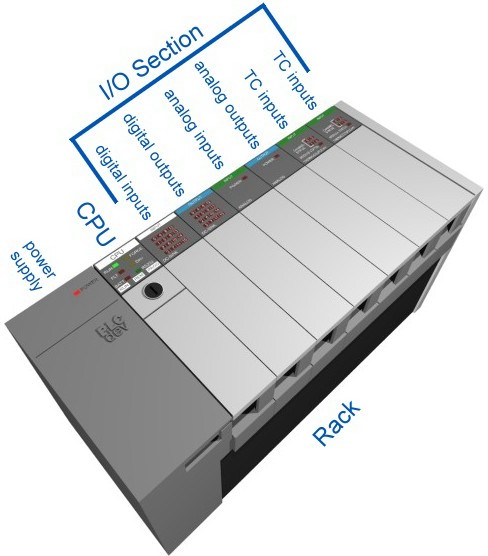
The Power Supply and Rack
So let’s start off by removing all our modules which leaves us with a naked PLC with only the power supply and the rack.
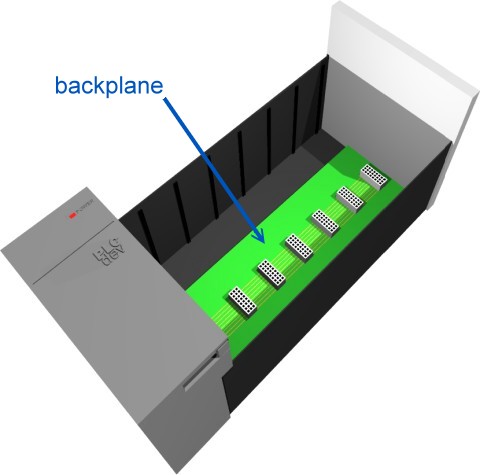
The rack is the component that holds everything together. Depending on the needs of the control system it can be ordered in different sizes to hold more modules. Like a human spine the rack has a backplane at the rear which allows the cards to communicate with the CPU. The power supply plugs into the rack as well and supplies a regulated DC power to other modules that plug into the rack. The most popular power supplies work with 120 VAC or 24 VDC sources.
The CPU
The brain of the whole PLC is the CPU module. This module typically lives in the slot beside the power supply. Manufacturers offer different types of CPUs based on the complexity needed for the system.
The CPU consists of a microprocessor, memory chip and other integrated circuits to control logic, monitoring and communications. The CPU has different operating modes. In programming mode it accepts the downloaded logic from a PC. The CPU is then placed in run mode so that it can execute the program and operate the process.
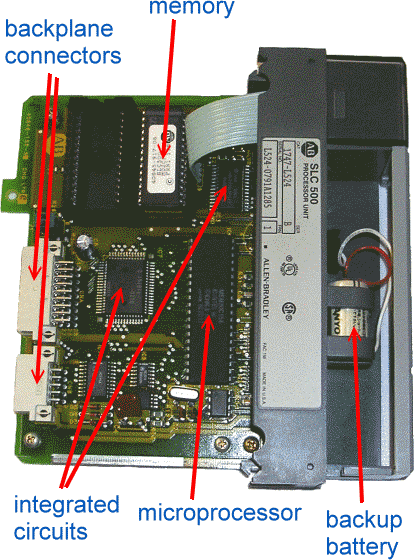
Since a PLC is a dedicated controller it will only process this one program over and over again. One cycle through the program is called a scan time and involves reading the inputs from the other modules, executing the logic based on these inputs and then updated the outputs accordingly. The scan time happens very quickly (in the range of 1/1000th of a second). The memory in the CPU stores the program while also holding the status of the I/O and providing a means to store values.
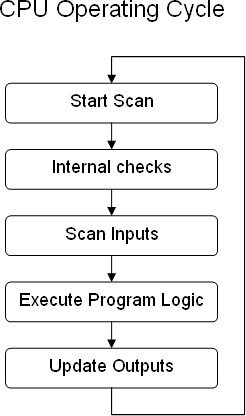
I/O System
The I/O system provides the physical connection between the equipment and the PLC. Opening the doors on an I/O card reveals a terminal strip where the devices connect.
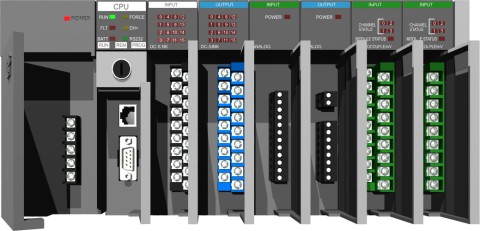
There are many different kinds of I/O cards which serve to condition the type of input or output so the CPU can use it for it’s logic. It's simply a matter of determining what inputs and outputs are needed, filling the rack with the appropriate cards and then addressing them correctly in the CPUs program.
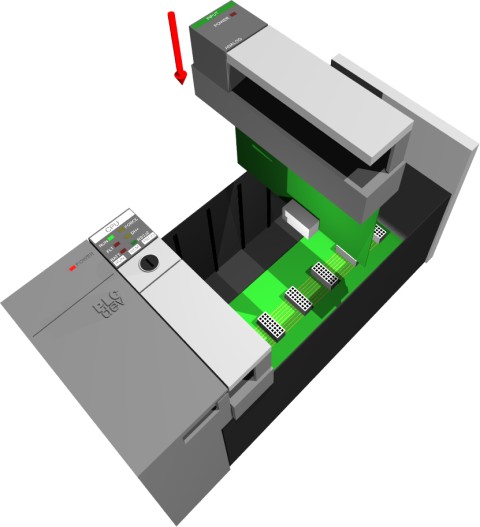
Inputs
Input devices can consist of digital or analog devices. A digital input card handles discrete devices which give a signal that is either on or off such as a pushbutton, limit switch, sensors or selector switches. An analog input card converts a voltage or current (e.g. a signal that can be anywhere from 0 to 20mA) into a digitally equivalent number that can be understood by the CPU. Examples of analog devices are pressure transducers, flow meters and thermocouples for temperature readings
Outputs
Output devices can also consist of digital or analog types. A digital output card either turns a device on or off such as lights, LEDs, small motors, and relays. An analog output card will convert a digital number sent by the CPU to it’s real world voltage or current. Typical outputs signals can range from 0-10 VDC or 4-20mA and are used to drive mass flow controllers, pressure regulators and position controls.
Programming a PLC
In these modern times a PC with specially dedicated software from the PLC manufacturer is used to program a PLC. The most widely used form of programming is called ladder logic. Ladder logic uses symbols, instead of words, to emulate the real world relay logic control, which is a relic from the PLC's history. These symbols are interconnected by lines to indicate the flow of current through relay like contacts and coils. Over the years the number of symbols has increased to provide a high level of functionality.
The completed program looks like a ladder but in actuality it represents an electrical circuit. The left and right rails indicate the positive and ground of a power supply. The rungs represent the wiring between the different components which in the case of a PLC are all in the virtual world of the CPU. So if you can understand how basic electrical circuits work then you can understand ladder logic.
In this simplest of examples a digital input (like a button connected to the first position on the card) when it is pressed turns on an output which energizes an indicator light.

The completed program is downloaded from the PC to the PLC using a special cable that’s connected to the front of the CPU. The CPU is then put into run mode so that it can start scanning the logic and controlling the outputs.
The Birth of the PLC
The Original Challenge
The early history of the PLC is fascinating. Imagine if you will a fifty foot long cabinet filled with relays whose function in life is to control a machine. Wires run in and out of the system as the relays click and clack to the logic. Now imagine there is a problem or a small design change and you have to figure it all out on paper and then shut down the machine, move some wires, add some relays, debug and do it all over again. Imagine the labor involved in the simplest of changes. This is the problem that faced the engineers at the Hydra-matic division of GM motors in the late 1960's.
Fortunately for them the prospect of computer control was rapidly becoming a reality for large corporations as themselves. So in 1968 the GM engineers developed a design criteria for a "standard machine controller". This early model simply had to replace relays but it also had to be:
- A solid-state system that was flexible like a computer but priced competitively with a like kind relay logic system.
- Easily maintained and programmed in line with the all ready accepted relay ladder logic way of doing things.
- It had to work in an industrial environment with all it's dirt, moisture, electromagnetism and vibration.
- It had to be modular in form to allow for easy exchange of components and expandability.
The Race is On
This was a tall order in 1968 but four companies took on the challenge.
- Information Instruments, Inc. (fully owned by Allen-Bradley a year later).
- Digital Equipment Corp. (DEC)
- Century Detroit
- Bedford Associates
Bedford Associates, run by Richard Morley, won the contract and quickly formed a new company around the technology called MODICON after Modular Digital Control. By June of 1969 they were selling the first viable Programmable Controller the "084" (their 84th project) which sold over one thousand units. These early experiences gave birth to their next model the "184" in 1973 which set Modicon as the early leader in programmable controllers.
Not to be outdone, the powerhouse Allen-Bradley (all ready known for it's rheostats, relays and motor controls) purchased Information Instruments in 1969 and began development on this new technology. The early models (PDQ-II and PMC) were deemed to be too large and complex. By 1971 Odo Struger and Ernst Dummermuth had begun to develop a new concept known as the Bulletin 1774 PLC which would make them successful for years to come. Allen-Bradley termed their new device the "Programmable Logic Controller" (patent #3,942,158) over the then accepted term "Programmable Controller". The PLC terminology became the industry standard especially when PC became associated with personal computers.